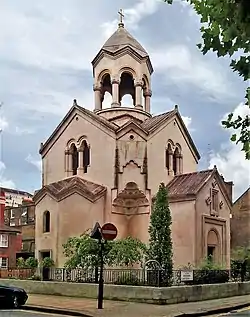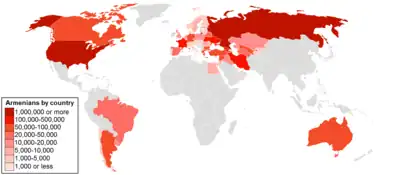Armenians in the United Kingdom
The Armenian community of the United Kingdom consists mainly of British citizens who are fully or partially of Armenian descent. There has been sporadic emigration from Armenia to the UK since the 18th century, with the biggest influx coming after the Second World War. The majority are based in the major cities of London and Manchester. The 2001 UK Census recorded 589 Armenian-born people living in the UK,[1] and in 2013, the Office for National Statistics estimated that there were 1,235 people born in Armenia resident in the UK, with the number of Armenian nationals being 1,720,[2] although it has been estimated by the Armenian Diaspora Conference that there are up to 18,000 ethnic Armenians including those who are British-born, and of part Armenian descent, living in the UK.[3]
| Total population | |
|---|---|
| 18,000 | |
| Regions with significant populations | |
| London, Manchester, Liverpool, Birmingham, Edinburgh | |
| Languages | |
| Armenian, English, Russian, Persian, Arabic, Turkish, French, Greek | |
| Religion | |
| Armenian Apostolic Church, Armenian Catholic Church, Armenian Evangelical Church |
| Part of a series on |
| Armenians |
|---|
 |
| Armenian culture |
| By country or region |
Armenian diaspora Russia |
| Subgroups |
| Religion |
| Languages and dialects |
| Persecution |
| Part of a series on |
| British people |
|---|
| United Kingdom |
| Eastern European |
| Northern European |
| Southern European |
| Western European |
| Central Asian |
| East Asian |
| South Asian |
| Southeast Asian |
| West Asian |
| African and Afro-Caribbean |
| Northern American |
| Latin American |
History
Antonia Gransden (University of Nottingham) writes about the visit to the monastery of St. Albans in 1228 of the Armenian Archbishop, and in 1252 the group of Armenians.[4] The first Armenian community in Britain was formed in Manchester in the 19th century. A mixture of textile traders, small manufacturers and retailers, in 1870 they opened the first Armenian church in Britain (the Holy Trinity Church located in Manchester).[5] In 1896 an estimated 500 Armenians lived in London.[6]

On 19 July 1920, Hovhannes Masehyan was appointed by the Armenian government to serve as "envoy extraordinary and minister plenipotentiary" of Armenia to Britain. However, his appointment was disallowed by the Foreign Office which felt "discomfort and embarrassment" at such a "veteran diplomat" representing an "unstable state" to which Britain had not yet granted de jure recognition. On 12 November 1920, the Foreign Office (and later Lord Curzon) acknowledged the appointment of Jaques Bagratuni as the unofficial representative of Armenia in London.[7]
Population distribution
According to Vered Amit's Armenians in London: The Management of Social Boundaries, published in 1989, around 10,000 Armenians were living in Greater London at the time. The majority were thought to be first-generation immigrants from Lebanon, Syria, Iraq, Iran and Cyprus.[8] They also include Armenians from Ethiopia, India, Egypt, Israel, as well as individuals from other countries.
Manchester has been home to an Armenian population since 1835, with 30 Armenian businesses thought to have been operating in the city by 1862.[9] Silk merchants were the original Armenian settlers in Manchester. In Easter 1870 Holy Trinity Church, an Armenian church, opened in Manchester, making it the first religious institution of that kind of in Western Europe. The Armenian Ladies Association of Manchester was in existence by the 1920s.[10] In the early 20th century, there were Armenian mercantile communities based in London and Manchester represented by James Malcolm and H. Kamberian—the latter later became the official consul of Armenia in Manchester with the approval of the Foreign Office in October 1920.[7]
Media
The Tekeyan Cultural Union published "Erebuni" from 1979 to 1996. From 1979 to 1987, it was a bilingual Armenian/English monthly, turning into a biweekly from 1987 to 1996. For a brief period in 1993, it was published solely in English before reverting into a bilingual edition. It ceased publication in 1996.
Churches
There are three Armenian Apostolic Churches in Britain: Saint Sarkis in Kensington in London; Saint Yeghiche in South Kensington, also in London; and the Holy Trinity in Chorlton-on-Medlock, Manchester. The Armenian church of the Holy Trinity was the first purpose-built Armenian church in Western Europe and was opened at Easter 1870. The architects were Royle & Bennett, 1869–70.[11][12] There is also an Armenian Christian Fellowship in Chiswick, West London, a non-denominational evangelical church with services in Armenian, English and Persian.[13] Nearby Chiswick New Cemetery has a significant number of Armenian burials.
Schools
Kevork Tahta Armenian Community Sunday School in London operates under the auspices of Armenian Community of UK, providing inclusive education to promote a better knowledge of the Armenian language and culture.[14]
List of notable British Armenians
- Armen Sarkissian, 4th president of Armenia
- Levon Chilingirian OBE, musician, the founder of the Chilingirian Quartet
- Ara Darzi, Baron Darzi of Denham KBE, surgeon and first British-Armenian peer
- Dame Sonia Rosemary Susan Proudman judge of the High Court of England and Wales
- David Dickinson, antiques expert and television presenter
- Calouste Gulbenkian, one of the founders of Royal Dutch Shell and oil magnate
- Robert Istepanian, professor of Data Communication at Kingston University[15]
- Baret Magarian, novelist
- Kevork Malikyan, actor, various TV roles including Mind Your Language, and films including Indiana Jones and the Last Crusade, Flight of the Phoenix
- Roland Manookian, actor, major role in the Football Factory by Nick Love
- Demis Ohandjanian, football player
- Kev Orkian, musician, comedian, actor
- Alexander Raphael, first person of Armenian descent to become a member of the House of Commons[16]
- Andy Serkis, actor, director, and author best known for playing Sméagol/Gollum, in The Lord of the Rings film trilogy
- Joe Strummer, lead singer of The Clash, musician
- Dikran Tahta, mathematician and teacher
References
- "Country-of-birth data, 2001". Organisation for Economic Co-operation and Development. Archived from the original on 2005-05-11. Retrieved 2008-09-14.
- "Nationality and country of birth by age, sex and qualifications Jan – Dec 2013". Office for National Statistics. 25 April 2014. Retrieved 20 June 2016.
- "Population". Armenian Diaspora Conference. Archived from the original on March 27, 2008. Retrieved 2008-09-14.
- Antonia Gransden. Historical Writing in England: c. 500 to c. 1307. — Routledge, 1996. — P. 318. "Matthew had excellent means of obtaining information. St Albans was within twenty miles of London, and had close connections, through its cells at Tynemouth, Belvoir, Binham and Wymondham, with the north, the midlands and East Anglia. Its guest-house served as a hotel for visitors from all over England and from abroad (in 1228 an Armenian archbishop, and in 1252 a group of Armenians, stayed in the abbey25). Henry III visited the abbey at least nine times before 1259."
- Celebrating the first Christian nation
- Yeghiazaryan, Ruben (2002). "Անգլիայի հայ գաղութը (1860–1920 թթ.) [Armenian Colony in England (1860–1920)]". Patma-Banasirakan Handes (in Armenian) (1): 65–87.
- Hovannisian, Richard G. (1996). The Republic of Armenia. Vol. 3. Berkeley: University of California Press. pp. 410–411. ISBN 0-520-01805-2.
- Talai, Vered Amit (1989). Armenians in London: The Management of Social Boundaries. Manchester: Manchester University Press. p. 1. ISBN 0-7190-2927-9.
- "Multi-Cultural Manchester: Armenians". Manchester City Council. Archived from the original on 2009-09-07. Retrieved 2009-08-22.
- "Armenian Merchants in Exile". Archives Plus. Manchester Central Library. Retrieved 2019-05-26.
- The architects chose an eclectic neo-Gothic style. At the east end is a rounded apse and the interior is simple though the altar is elaborate.--Hartwell, Clare; Hyde, Matthew & Pevsner, Nikolaus (2004) Lancashire: Manchester and the South-East. New Haven: Yale University Press; pp. 421–22
- "The Holy Trinity Armenian Church of Manchester". Holy Trinity Armenian Church. 2009. Retrieved 14 December 2010.
- "About us". www.armenianicf.com. Retrieved 2020-09-07.
- "History – K. Tahta Armenian Community Sunday School". Retrieved 2022-01-16.
- "Faculty of Science, Engineering and Computing – Kingston University London".
- Seth, Mesrovb Jacob (1937). Armenians in India: From the Earliest Times to the Present. Calcutta: Asian Educational Services. p. 595. ISBN 978-81-206-0812-2.
Further reading
- Talai, Vered Amit (1986). "The circumscription of ethnicity: a case study of the London Armenian community". Ethnic and Racial Studies. 9 (2): 211–18. doi:10.1080/01419870.1986.9993523.
- Talai, Vered Amit (1989). Armenians in London: the management of social boundaries. Manchester University Press. ISBN 978-0-7190-2927-1.
- Malik, Farah (1990). A Survey of the Armenian Community in London. London Research Centre. ISBN 978-1-85261-100-2.
